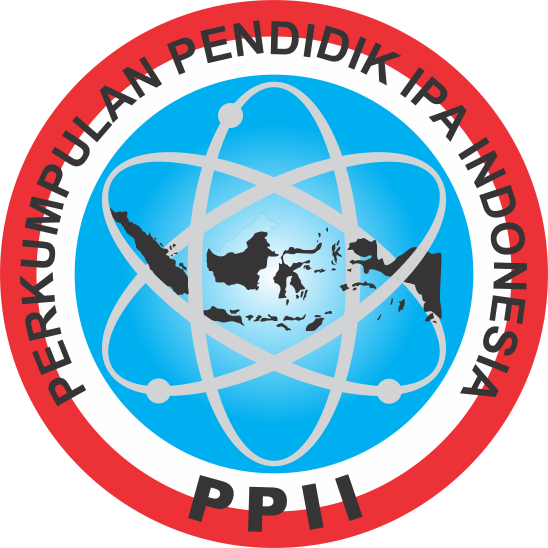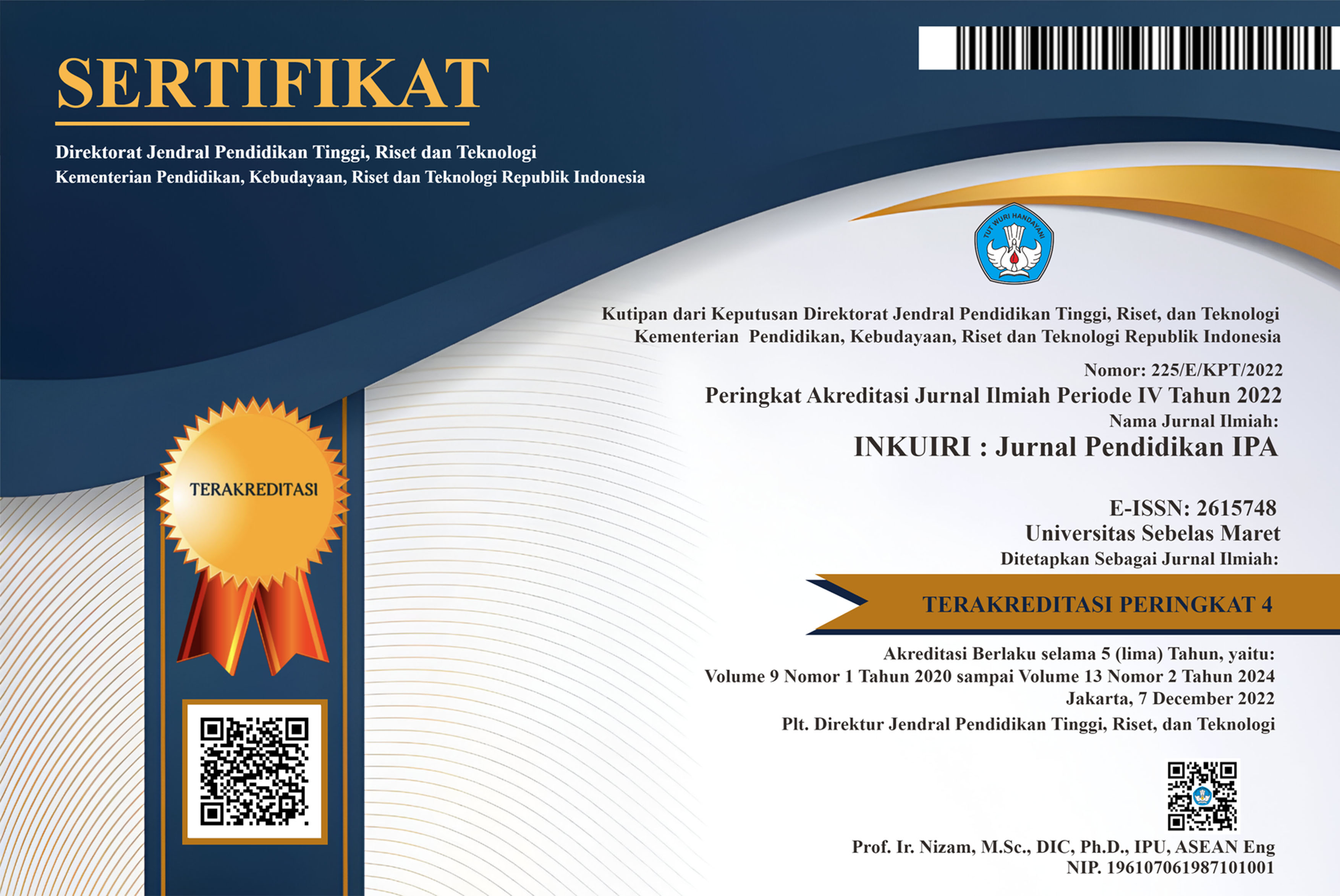Pengaruh Media Augmented Reality Untuk Meningkatkan Pemahaman Konsep Siswa Kelas IV SDN Tegalkalong pada Materi Fotosintesis
Abstract
Pada hakikatnya kegiatan belajar mengajar adalah suatu proses interaksi atau hubungan timbal balik antar guru dan siswa baik secara formal maupun non formal. Guru merupakan fasilitator terhadap segenap pembelajaran yang tersaji pada aktivitas pembelajaran yang dibawakannya. Oleh karena itu, diperlukan pemahaman konsep yang dapat dimengerti siswa dan disampaikan dengan baik oleh guru. Penelitian ini bertujuan untuk mengetahui pengaruh media pembelajaran berbasis Augmented Reality (AR) untuk meningkatkan pemahaman konsep siswa kelas IV SDN Tegalakalong pada materi fotosintesis. Media pembelajaran yang digunakan dibuat menggunakan aplikasi yang dapat diakses oleh semua orang yaitu Assemblr studio dalam https://www.assemblrworld.com/studio. Populasi penelitian ini dilakukan pada siswa kelas IV A dan IV B SDN Tegalkalong Sumedang. Metode penelitian yang digunakan dalam penelitian ini menggunakan kuasi eksperimen dengan desain non equivalent group design, dengan teknik pengumpulan data berupa tes (pretest dan postest). Data dianalisis secara kuantitatif dengan menggunakan software IBM SPSS Statistics dengan beberapa tahap analisis yang dimulai dari analisis deskriptif, analisis normalitas, analisis paired sample t test, analisis homogenitas, dan analisis independent sample t test. Hasil yang didapat dari prosses analisis, diperoleh kesimpulan: terdapat pengaruh media pembelajaran berbasis Augmented Reality terhadap penguasaan konsep siswa yang tegak lurus dengan hasil belajar siswa kelas IV A terhadap materi pembelajaran fotosintesis. Selisih rata-rata dari hasil nilai postest yang telah dilakukan sebesar 11,03.
In essence, teaching and learning activities are a process of interaction or reciprocal relationships between teachers and students both formally and informally. The teacher is a facilitator of all the learning presented in the learning activities he presents. Therefore, it is necessary to understand concepts that students can understand and convey well by the teacher. This study aims to determine the influence of Augmented Reality (AR)-based learning media to improve the understanding of the concept of grade IV students of SDN Tegalakalong on photosynthesis material. The learning media used is made using an application that can be accessed by everyone, namely Assemblr studio in https://www.assemblrworld.com/studio. The population of this study was conducted on students of grade IV A and IV B SDN Tegalkalong Sumedang. The research method used in this study used quasi-experiment with a non-equivalent group design, with data collection techniques in the form of tests (pretest and postest). The data was analyzed quantitatively using IBM SPSS Statistics software with several stages of analysis starting from descriptive analysis, normality analysis, paired sample t test analysis, homogeneity analysis, and independent sample t test analysis. Results obtained from the analysis process, Conclusion: there is an influence of Augmented Reality-based learning media on mastery of student concepts that are perpendicular to the learning outcomes of grade IV A students on photosynthesis learning material. The average difference from the results of the postest score that has been carried out is 11.03.
Keywords
Full Text:
PDFReferences
Abraham, I., & Supriyati, Y. (n.d.). DESAIN KUASI EKSPERIMEN DALAM PENDIDAl-Qaysi, N., Mohamad-Nordin, N., & Al-Emran, M. (2020). A Systematic Review of Social Media Acceptance From the Perspective of Educational and Information Systems Theories and Models. Journal of Educational Computing Research, 57(8), 2085–2109. https://doi.org/10.1177/0735633118817879
Aziz, H. (2018). Education 4.0 Made Simple: Ideas For Teaching. International Journal of Education and Literacy Studies, 6(3), 92–98. https://journals.aiac.org.au/index.php/IJELS/article/view/4616
Daniel, B. K., & Harland, T. (2017). Higher Education Research Methodology. Higher Education Research Methodology. https://doi.org/10.4324/9781315149783
Harsiwi, U. B., & Arini, L. D. D. (2020). Pengaruh Pembelajaran Menggunakan Media Pembelajaran Interaktif terhadap Hasil Belajar siswa di Sekolah Dasar. Jurnal Basicedu, 4(4), 1104–1113. https://doi.org/10.31004/basicedu.v4i4.505
Kazanidis, I., Pellas, N., & Christopoulos, A. (2021). A learning analytics conceptual framework for augmented reality-supported educational case studies. Multimodal Technologies and Interaction, 5(3). https://doi.org/10.3390/mti5030009
Mann, S., Furness, T., Yuan, Y., Iorio, J., & Wang, Z. (2018). All Reality: Virtual, Augmented, Mixed (X), Mediated (X,Y), and Multimediated Reality. X. http://arxiv.org/abs/1804.08386
Mohd Zaidi, N. N., & Mesbahul Hoque. (2019). Application of E-Learning for Teaching Hadith in Higher Education Institutional Education in Malaysia: A Literature Review. Journal of Quran Sunnah Education & Special Needs, 3(2), 28–34. https://doi.org/10.33102/jqss.vol3no2.50
Nopaldi, A., & Setiawati, S. (2018). Hubungan antara Motivasi Belajar dengan Minat Belajar Warga Binaan pada Keterampilan Menjahit di Panti Sosial Karya Wanita Andam Dewi Solok. SPEKTRUM: Jurnal Pendidikan Luar Sekolah (PLS), 6(4), 400. https://doi.org/10.24036/spektrumpls.v1i4.101463
Nur Aeni, A., Nur Nofriani, A., Ayuni Fauziah, I., & Ahmad Fauzi, I. (2022). Pemanfaatan Media Animasi Berbasis Aplikasi Renderforest Dalam Membentuk Kepribadian Islami Bagi Siswa Sekolah Dasar Kelas 4. Jurnal Pendidikan Dan Teknologi Indonesia, 2(6), 279–287. https://doi.org/10.52436/1.jpti.183
Pas, E. T., Ryoo, J. H., Musci, R. J., & Bradshaw, C. P. (2019). A state-wide quasi-experimental effectiveness study of the scale-up of school-wide Positive Behavioral Interventions and Supports. Journal of School Psychology, 73(January), 41–55. https://doi.org/10.1016/j.jsp.2019.03.001
Safitri, H. I., & Harun, H. (2020). Membiasakan Pola Hidup Sehat dan Bersih pada Anak Usia Dini Selama Pandemi Covid-19. Jurnal Obsesi : Jurnal Pendidikan Anak Usia Dini, 5(1), 385. https://doi.org/10.31004/obsesi.v5i1.542
Sodiq Anshori. (2017). Pemanfaatan Tik Sebagai Sumber Dan Media Pembelajaran Di Sekolah. Civic-Culture: Jurnal Ilmu Pendidikan PKn Dan Sosial Budaya, 10–20.
Starkey, L. (2020). A review of research exploring teacher preparation for the digital age. Cambridge Journal of Education, 50(1), 37–56. https://doi.org/10.1080/0305764X.2019.1625867
Wahidmurni. (2017). 済無No Title No Title No Title. 7(Snip), 2588–2593.
IKAN: LITERATUR REVIEW. Jurnal Ilmiah Mandala Education (JIME), 8(3), 2442–9511. https://doi.org/10.36312/jime.v8i3.3800/http
Adzandini, N. (n.d.). Augmented Reality as a 21 st Century History Education Media.
Aeni, A. N., Djuanda, D., Maulana, M., Nursaadah, R., & Sopian, S. B. P. (2022). PENGEMBANGAN APLIKASI GAMES EDUKATIF WORDWALL SEBAGAI MEDIA PEMBELAJARAN UNTUK MEMAHAMI MATER PENDIDIKAN AGAMA ISLAM BAGI SISWA SD. Primary: Jurnal Pendidikan Guru Sekolah Dasar, 11(6), 1835. https://doi.org/10.33578/jpfkip.v11i6.9313
Al-Qaysi, N., Mohamad-Nordin, N., & Al-Emran, M. (2020). A Systematic Review of Social Media Acceptance From the Perspective of Educational and Information Systems Theories and Models. Journal of Educational Computing Research, 57(8), 2085–2109. https://doi.org/10.1177/0735633118817879
Aziz, H. (2018). Education 4.0 Made Simple: Ideas For Teaching. International Journal of Education and Literacy Studies, 6(3), 92–98. https://journals.aiac.org.au/index.php/IJELS/article/view/4616
Daniel, B. K., & Harland, T. (2017). Higher Education Research Methodology. Higher Education Research Methodology. https://doi.org/10.4324/9781315149783
Harsiwi, U. B., & Arini, L. D. D. (2020). Pengaruh Pembelajaran Menggunakan Media Pembelajaran Interaktif terhadap Hasil Belajar siswa di Sekolah Dasar. Jurnal Basicedu, 4(4), 1104–1113. https://doi.org/10.31004/basicedu.v4i4.505
Kazanidis, I., Pellas, N., & Christopoulos, A. (2021). A learning analytics conceptual framework for augmented reality-supported educational case studies. Multimodal Technologies and Interaction, 5(3). https://doi.org/10.3390/mti5030009
Mann, S., Furness, T., Yuan, Y., Iorio, J., & Wang, Z. (2018). All Reality: Virtual, Augmented, Mixed (X), Mediated (X,Y), and Multimediated Reality. X. http://arxiv.org/abs/1804.08386
Mohd Zaidi, N. N., & Mesbahul Hoque. (2019). Application of E-Learning for Teaching Hadith in Higher Education Institutional Education in Malaysia: A Literature Review. Journal of Quran Sunnah Education & Special Needs, 3(2), 28–34. https://doi.org/10.33102/jqss.vol3no2.50
Nopaldi, A., & Setiawati, S. (2018). Hubungan antara Motivasi Belajar dengan Minat Belajar Warga Binaan pada Keterampilan Menjahit di Panti Sosial Karya Wanita Andam Dewi Solok. SPEKTRUM: Jurnal Pendidikan Luar Sekolah (PLS), 6(4), 400. https://doi.org/10.24036/spektrumpls.v1i4.101463
Nur Aeni, A., Nur Nofriani, A., Ayuni Fauziah, I., & Ahmad Fauzi, I. (2022). Pemanfaatan Media Animasi Berbasis Aplikasi Renderforest Dalam Membentuk Kepribadian Islami Bagi Siswa Sekolah Dasar Kelas 4. Jurnal Pendidikan Dan Teknologi Indonesia, 2(6), 279–287. https://doi.org/10.52436/1.jpti.183
Pas, E. T., Ryoo, J. H., Musci, R. J., & Bradshaw, C. P. (2019). A state-wide quasi-experimental effectiveness study of the scale-up of school-wide Positive Behavioral Interventions and Supports. Journal of School Psychology, 73(January), 41–55. https://doi.org/10.1016/j.jsp.2019.03.001
Safitri, H. I., & Harun, H. (2020). Membiasakan Pola Hidup Sehat dan Bersih pada Anak Usia Dini Selama Pandemi Covid-19. Jurnal Obsesi : Jurnal Pendidikan Anak Usia Dini, 5(1), 385. https://doi.org/10.31004/obsesi.v5i1.542
Sodiq Anshori. (2017). Pemanfaatan Tik Sebagai Sumber Dan Media Pembelajaran Di Sekolah. Civic-Culture: Jurnal Ilmu Pendidikan PKn Dan Sosial Budaya, 10–20.
Starkey, L. (2020). A review of research exploring teacher preparation for the digital age. Cambridge Journal of Education, 50(1), 37–56. https://doi.org/10.1080/0305764X.2019.1625867
Wahidmurni. (2017). 済無No Title No Title No Title. 7(Snip), 2588–2593.
Refbacks
- There are currently no refbacks.






